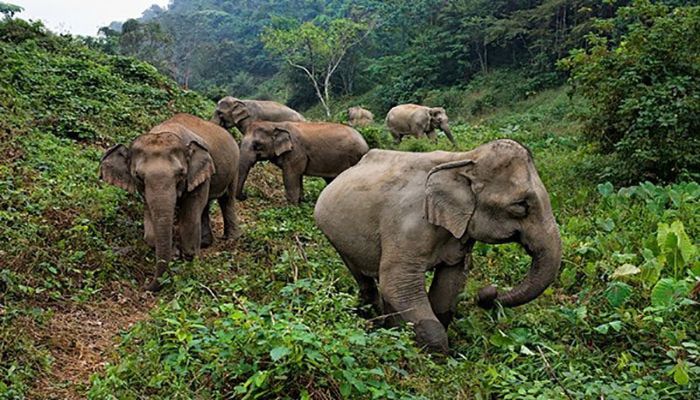
Desk Report
Publish: 21 Jun 2022, 07:05 pm

Photo: Collected
Bangladesh Forest Department has decided to implement a project to conserve wild elephants and minimise elephant-human conflicts, as a number of wild mammoths have been killed in recent years.
“We have already formulated a Taka 50-crore project titled ‘Elephant Conservation Project’ and sent it to the Planning Commission,” Mollah Rezaul Karim, Conservator of Forests at Wildlife and Nature Conservation Circle, told BSS.
He said once the project gets clearance from the Planning Commission, the Forest Department will start work for implementation of the project.
According to the project details, 1,400 hectares of orchards having plants that elephants prefer to eat, 150 hectares of calamus palm garden and 250 hectares of bamboo garden will be created aiming to ensure safe habitat, breeding and food security for elephants.
To ensure daily water demand of the wild elephants, 15 small-big water bodies and 50 saltlicks will be built at their habitats.
About 100-kilometre solar-powered barred fencing will be set up along the ecological boundaries of vulnerable forests and villages to minimise human-elephant conflicts.
Besides, about 160-kilometre of ecological boundary bio-fencing with calamus tenuis plants and lemon and Indian jujube (boroi) trees will be established to minimise human-elephant conflicts.
Anti Depredation Squads (ADSs) will be formed at elephant reserves, while 68 new Elephant Response Teams (ERTs) will be created and the existing 127 ERTs will remain operational under the project.
Vests, shoes, shirts, pants, backpacks, caps, torchlight and gumboots will be distributed among the members of ADSs and ERTs so that they can carry out drives amid adverse environment to prevent human-elephant conflicts.
Some 90 RCC towers and 100 traditional tree towers will be set up to monitor the movement of mammoths. An elephant orphanage will be established to ensure safe shelter for baby, sick and injured elephants, forest conservators said.
In cultivating the crops like ginger, turmeric, lemon, citrus fruits, chili and pineapple that the elephants do not like, seeds and saplings will be distributed among farmers, and they will be given training and financial assistance too.
Elephant population estimation and habitat assessment survey will be carried out to identify the present state of their habitats and number.
Computer and mobile-based apps will be developed to conduct research on the mammoths.
Under the project, an ambassador will be appointed to create public opinion on elephant conservation.
In addition, the areas prone to human-elephant conflicts and the families vulnerable to elephant attacks will be identified. Elephant conservation committees will be formed at national, divisional, zila and upazila levels.
In Bangladesh, the highest number of wild elephants is found in the Chittagong Hill Tracts (CHT) apart from some in Chittagong and Cox’s Bazar Forest Divisions, and Mymensingh and Sylhet areas.
Due to fragmentation of habitats, elephant ranges in Bangladesh have become confined to small patches occupied by a single or few small herds.
Some corridors have been totally abandoned due to degradation of forest cover, extension of human settlements, intensification of agricultural practice, unsustainable slush and burn practice, unplanned road construction and establishment of monoculture forests.
Due to the rise of wildlife crimes in recent years, around 34 elephants were killed in 2021, according to unofficial data. Rezaul Karim said over 50 elephants were killed across the country in the last five years.
The elephant population continues to decline as they live under constant threat of their habitat destruction and deforestation, as well as illegal poaching for the ivory.
An IUCN 2016 survey found only 268 resident wild elephants in Bangladesh, all residing in southeastern forest areas of the country.
In the global context, Asian elephant is currently listed as ‘endangered species’ and classified under Appendix-I in the Convention on International Trade in Endangered Species of Wild Fauna and Flora.
Source: BSS
Subscribe Shampratik Deshkal Youtube Channel
© 2024 Shampratik Deshkal All Rights Reserved. Design & Developed By Root Soft Bangladesh